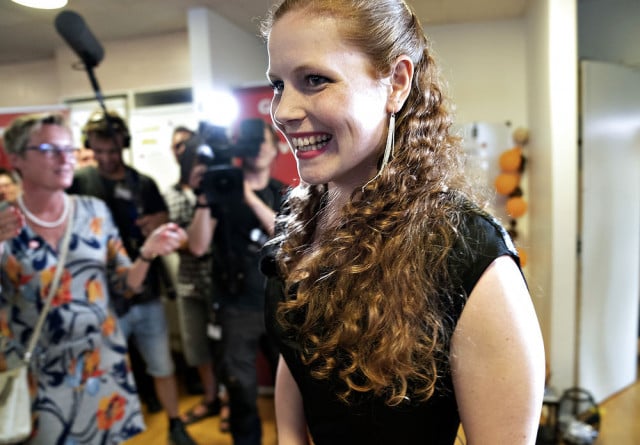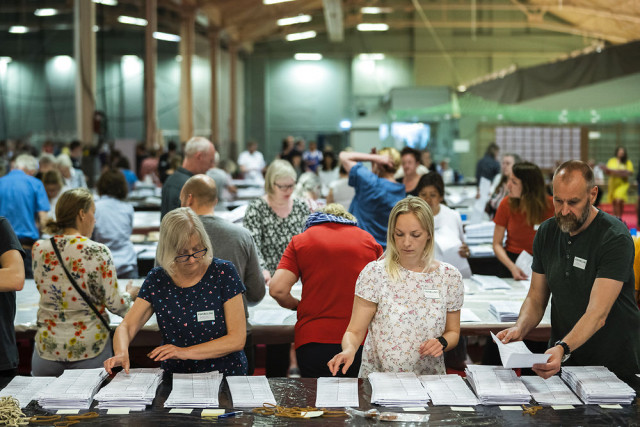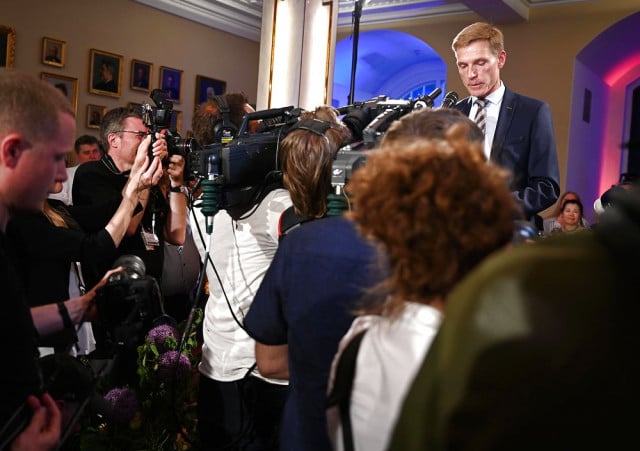What we learned: Seven things to know about the Danish election result

While the final government constellation is yet to be determined, Mette Frederiksen is set to become Denmark’s new prime minister after Wednesday’s election gave the left wing parties an overall majority.
But what else does yesterday’s voting tell us?
Hype around outsiders, but only one makes it into parliament
Three new parties, plus the Christian Democrats who due to their tiny vote share have been out of parliament since 2005, could have taken seats last night.
In the event, only the New Right – a party with a hardline anti-immigration and libertarian economic platform – hit the 2 percent threshold needed to qualify for parliamentary representation.
Klaus Riskær Pedersen announced he would quit politics and disband his party, while controversial Stram Kurs and their leader Rasmus Paludan were also shut out, although they looked very close to getting the votes they needed at one stage of the evening.
The Christian Democrats took a 1.7 percent share but finished just 190 votes short of re-entering parliament via a so-called kredsmandat (constituency mandate), awarded if a party has very high support locally. The party came agonisingly close to this in West Jutland, but it wasn’t quite enough.

Christian Democrat acting leader Isabella Arendt was confident early in the evening, but was left ultimately disappointed. Photo: Keld Navntoft/Ritzau Scanpix
Alternative party not needed by Frederiksen
The voter swing from right to left was a relatively large one. In 2015, 47 percent of voters cast their ballots for the four traditional left-of-centre parties (Social Democrats, Social Liberals, Red Green Alliance, Socialist People’s Party). That increased to 52.5 percent this time around.
The environmentalist Alternative party could have thrown a spanner in the works had the four traditional left-wing parties come up short of an overall majority.
Uffe Elbæk, leader of the green party, has said he would not back Frederiksen as PM and instead put himself forward as candidate for the top job, in an unusual move.
But Alternative saw its vote share decline, while other climate-focused parties – notably the Socialist People’s Party – prospered, giving an outright majority for the ‘red bloc’.
Failure of fringe parties means wasted votes
When parties don’t hit the threshold vote share for entering parliament (more about this here), their votes are effectively rendered lost – they have no influence on the distribution of seats.
With a total of 4.3 percent voting for either Klaus Riskær Pedersen, Stram Kurs or the Christian Democrats, the mainstream conservative parties may be left rueing what might have been if these votes had instead gone to them.
The 4.3 percent ‘vote loss’ is the highest since 1990, Rune Stubager, political science professor at Aarhus University, said at a press briefing on Thursday.

Votes being counted in Copenhagen. Photo: Martin Sylvest / Ritzau Scanpix
‘Establishment’ parties did well
Danish prime ministers have only ever come from one of four parties – the Liberals, Social Democrats, Social Liberals and Conservatives, all of which have existed for over 100 years.
All four of these ‘old money’ parties did well on Wednesday. The Social Democrats saw a marginal drop in vote share, but still gained a seat. The other three parties all saw significant improvements on their performances in 2015.
READ ALSO: Danish election results: New government for Denmark as left tops poll
This must feel like a pyrrhic victory for outgoing PM Lars Løkke Rasmussen and the Liberals, who lose power despite having an excellent election.
Populist right crumbles
It’s hard to use any word other than ‘disaster’ to describe the Danish People’s Party’s (DF) election.
Cut from 21 percent in 2015 to 8.7 percent last night, the party has lost 21 seats.
High-profile DF parliamentarians likely to lose their seats include hardline immigration spokesperson Martin Henriksen and EU spokesperson Kenneth Kristensen Berth, Ritzau reported early on Thursday.
DF are down to one seat in the Copenhagen greater constituency, where Henriksen probably has fewer personal votes than Peter Skaarup, who has a senior position within the party, Ritzau writes.
The party’s loss in vote share is reportedly the biggest ever suffered in Danish politics, Stubager said.
It’s also worth noting that, if you tally up the vote shares of DF with the two far-right newcomers, New Right and Stram Kurs, you get a total of 12.9 percent of the population voting for parties with a primarily anti-immigration platform.
“This is where the Danish People’s Party has been in most elections prior to 2015. So it seems that the support in the electorate, or the share of voters who have a tough stance on immigration as their main priority, is around 13 percent,” Stubager said.
 Danish People's Party leader Kristian Thulesen Dahl on election night. Photo: Philip Davali / Ritzau Scanpix
Danish People's Party leader Kristian Thulesen Dahl on election night. Photo: Philip Davali / Ritzau Scanpix
Rasmussen's unpredictability did Liberals no harm
Although they’ll be rueing their loss of power (as mentioned above), Lars Løkke Rasmussen’s Liberals did better than anyone was expecting. Was this because of Rasmussen’s unpredictability?
The outgoing PM flirted with a potential cross-aisle grand coalition with the Social Democrats early in the campaign and, on the eve of the election itself, Rasmussen said he was now making a government partnership with his erstwhile rivals his first choice.
They also did very well in the European elections last month.
“Nobody had really seen (a strong return for the Liberals) coming,” Stubager said.
A swing in the final days of the campaign is the most likely reason for the unexpected result, the analyst said.
“It seems (Rasmussen reaching out to the Social Democrats) is not scaring voters away. He may be tapping into centrist voters who didn’t want the extremes, particularly the right-wing extremes I would guess, to have too much influence,” he said.
Nevertheless, a minority Social Democrat government led by Frederiksen seems the most likely outcome.
High profiles lose seats
Henriksen and Berth are not the only big names to lose seats.
Aside from DF, the other party left licking its wounds this morning is the libertarian Liberal Alliance, who lost 9 seats – including that of leader and outgoing foreign minister Anders Samuelsen.
“I can become a political analyst now,” a grimacing Samuelsen said during DR’s post-election leader debate late last night.
With only four seats remaining and now the smallest party in parliament, Liberal Alliance face an uncertain future.
READ ALSO: Meet Denmark's next Prime Minister, the face of the new Social Democratic model
Comments
See Also
But what else does yesterday’s voting tell us?
Hype around outsiders, but only one makes it into parliament
Three new parties, plus the Christian Democrats who due to their tiny vote share have been out of parliament since 2005, could have taken seats last night.
In the event, only the New Right – a party with a hardline anti-immigration and libertarian economic platform – hit the 2 percent threshold needed to qualify for parliamentary representation.
Klaus Riskær Pedersen announced he would quit politics and disband his party, while controversial Stram Kurs and their leader Rasmus Paludan were also shut out, although they looked very close to getting the votes they needed at one stage of the evening.
The Christian Democrats took a 1.7 percent share but finished just 190 votes short of re-entering parliament via a so-called kredsmandat (constituency mandate), awarded if a party has very high support locally. The party came agonisingly close to this in West Jutland, but it wasn’t quite enough.

Christian Democrat acting leader Isabella Arendt was confident early in the evening, but was left ultimately disappointed. Photo: Keld Navntoft/Ritzau Scanpix
Alternative party not needed by Frederiksen
The voter swing from right to left was a relatively large one. In 2015, 47 percent of voters cast their ballots for the four traditional left-of-centre parties (Social Democrats, Social Liberals, Red Green Alliance, Socialist People’s Party). That increased to 52.5 percent this time around.
The environmentalist Alternative party could have thrown a spanner in the works had the four traditional left-wing parties come up short of an overall majority.
Uffe Elbæk, leader of the green party, has said he would not back Frederiksen as PM and instead put himself forward as candidate for the top job, in an unusual move.
But Alternative saw its vote share decline, while other climate-focused parties – notably the Socialist People’s Party – prospered, giving an outright majority for the ‘red bloc’.
Failure of fringe parties means wasted votes
When parties don’t hit the threshold vote share for entering parliament (more about this here), their votes are effectively rendered lost – they have no influence on the distribution of seats.
With a total of 4.3 percent voting for either Klaus Riskær Pedersen, Stram Kurs or the Christian Democrats, the mainstream conservative parties may be left rueing what might have been if these votes had instead gone to them.
The 4.3 percent ‘vote loss’ is the highest since 1990, Rune Stubager, political science professor at Aarhus University, said at a press briefing on Thursday.

Votes being counted in Copenhagen. Photo: Martin Sylvest / Ritzau Scanpix
‘Establishment’ parties did well
Danish prime ministers have only ever come from one of four parties – the Liberals, Social Democrats, Social Liberals and Conservatives, all of which have existed for over 100 years.
All four of these ‘old money’ parties did well on Wednesday. The Social Democrats saw a marginal drop in vote share, but still gained a seat. The other three parties all saw significant improvements on their performances in 2015.
READ ALSO: Danish election results: New government for Denmark as left tops poll
This must feel like a pyrrhic victory for outgoing PM Lars Løkke Rasmussen and the Liberals, who lose power despite having an excellent election.
Populist right crumbles
It’s hard to use any word other than ‘disaster’ to describe the Danish People’s Party’s (DF) election.
Cut from 21 percent in 2015 to 8.7 percent last night, the party has lost 21 seats.
High-profile DF parliamentarians likely to lose their seats include hardline immigration spokesperson Martin Henriksen and EU spokesperson Kenneth Kristensen Berth, Ritzau reported early on Thursday.
DF are down to one seat in the Copenhagen greater constituency, where Henriksen probably has fewer personal votes than Peter Skaarup, who has a senior position within the party, Ritzau writes.
The party’s loss in vote share is reportedly the biggest ever suffered in Danish politics, Stubager said.
It’s also worth noting that, if you tally up the vote shares of DF with the two far-right newcomers, New Right and Stram Kurs, you get a total of 12.9 percent of the population voting for parties with a primarily anti-immigration platform.
“This is where the Danish People’s Party has been in most elections prior to 2015. So it seems that the support in the electorate, or the share of voters who have a tough stance on immigration as their main priority, is around 13 percent,” Stubager said.
 Danish People's Party leader Kristian Thulesen Dahl on election night. Photo: Philip Davali / Ritzau Scanpix
Danish People's Party leader Kristian Thulesen Dahl on election night. Photo: Philip Davali / Ritzau Scanpix
Rasmussen's unpredictability did Liberals no harm
Although they’ll be rueing their loss of power (as mentioned above), Lars Løkke Rasmussen’s Liberals did better than anyone was expecting. Was this because of Rasmussen’s unpredictability?
The outgoing PM flirted with a potential cross-aisle grand coalition with the Social Democrats early in the campaign and, on the eve of the election itself, Rasmussen said he was now making a government partnership with his erstwhile rivals his first choice.
They also did very well in the European elections last month.
“Nobody had really seen (a strong return for the Liberals) coming,” Stubager said.
A swing in the final days of the campaign is the most likely reason for the unexpected result, the analyst said.
“It seems (Rasmussen reaching out to the Social Democrats) is not scaring voters away. He may be tapping into centrist voters who didn’t want the extremes, particularly the right-wing extremes I would guess, to have too much influence,” he said.
Nevertheless, a minority Social Democrat government led by Frederiksen seems the most likely outcome.
High profiles lose seats
Henriksen and Berth are not the only big names to lose seats.
Aside from DF, the other party left licking its wounds this morning is the libertarian Liberal Alliance, who lost 9 seats – including that of leader and outgoing foreign minister Anders Samuelsen.
“I can become a political analyst now,” a grimacing Samuelsen said during DR’s post-election leader debate late last night.
With only four seats remaining and now the smallest party in parliament, Liberal Alliance face an uncertain future.
READ ALSO: Meet Denmark's next Prime Minister, the face of the new Social Democratic model
Join the conversation in our comments section below. Share your own views and experience and if you have a question or suggestion for our journalists then email us at [email protected].
Please keep comments civil, constructive and on topic – and make sure to read our terms of use before getting involved.
Please log in here to leave a comment.